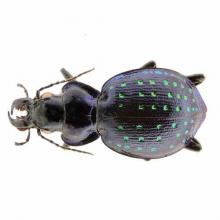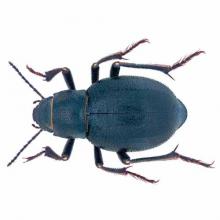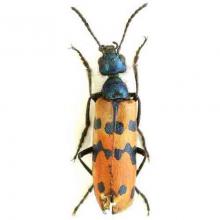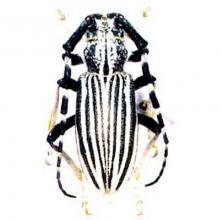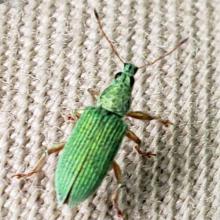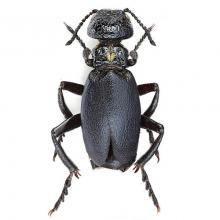Calosoma fischeri
Common name:
Fischer's caterpillar hunter
Suborder:
Adephaga
Order:
Coleoptera
Class:
Insecta
Sternoplax zichyi
Common name:
Darkling beetle
Suborder:
Polyphaga
Order:
Coleoptera
Class:
Insecta
Mylabris mongolica
Common name:
Northern blisterbeetle
Suborder:
-n/a-
Order:
Coleoptera
Class:
Insecta
Eodorcadion gorbunovi
Common name:
Longhorn beetle
Suborder:
Polyphaga
Order:
Coleoptera
Class:
Insecta
Rhaebus komarovi
Common name:
Weevil
Suborder:
Polyphaga
Order:
Coleoptera
Class:
Insecta
Meloe centripubens
Common name:
Blister beetle
Suborder:
Polyphaga
Order:
Coleoptera
Class:
Insecta
Calosoma fischeri
Common name:
Fischer's caterpillar hunter
Suborder:
Adephaga
Order:
Coleoptera
Class:
Insecta
Sternoplax zichyi
Common name:
Darkling beetle
Suborder:
Polyphaga
Order:
Coleoptera
Class:
Insecta
Mylabris mongolica
Common name:
Northern blisterbeetle
Suborder:
-n/a-
Order:
Coleoptera
Class:
Insecta
Eodorcadion gorbunovi
Common name:
Longhorn beetle
Suborder:
Polyphaga
Order:
Coleoptera
Class:
Insecta
Rhaebus komarovi
Common name:
Weevil
Suborder:
Polyphaga
Order:
Coleoptera
Class:
Insecta
Meloe centripubens
Common name:
Blister beetle
Suborder:
Polyphaga
Order:
Coleoptera
Class:
Insecta
Calosoma fischeri
Common name:
Fischer's caterpillar hunter
Suborder:
Adephaga
Order:
Coleoptera
Class:
Insecta
Sternoplax zichyi
Common name:
Darkling beetle
Suborder:
Polyphaga
Order:
Coleoptera
Class:
Insecta
Mylabris mongolica
Common name:
Northern blisterbeetle
Suborder:
-n/a-
Order:
Coleoptera
Class:
Insecta
Eodorcadion gorbunovi
Common name:
Longhorn beetle
Suborder:
Polyphaga
Order:
Coleoptera
Class:
Insecta
Rhaebus komarovi
Common name:
Weevil
Suborder:
Polyphaga
Order:
Coleoptera
Class:
Insecta
Meloe centripubens
Common name:
Blister beetle
Suborder:
Polyphaga
Order:
Coleoptera
Class:
Insecta
Order (Animalia): Coleoptera
Beetles are a group of insects that form the order Coleoptera (/koʊliːˈɒptərə/), in the superorder Endopterygota. Their front pair of wings are hardened into wing-cases, elytra, distinguishing them from most other insects. The Coleoptera, with about 400,000 species, is the largest of all orders, constituting almost 40% of described insects and 25% of all known animal life-forms; new species are discovered frequently. The largest of all families, the Curculionidae (weevils), with some 83,000 member species, belongs to this order. Found in almost every habitat except the sea and the polar regions, they interact with their ecosystems in several ways: beetles often feed on plants and fungi, break down animal and plant debris, and eat other invertebrates. Some species are serious agricultural pests, such as the Colorado potato beetle, while others such as Coccinellidae (ladybirds or ladybugs) eat aphids, scale insects, thrips, and other plant-sucking insects that damage crops.
Beetles typically have a particularly hard exoskeleton including the elytra, though some such as the rove beetles have very short elytra while blister beetles have softer elytra. The general anatomy of a beetle is quite uniform and typical of insects, although there are several examples of novelty, such as adaptations in water beetles which trap air bubbles under the elytra for use while diving. Beetles are endopterygotes, which means that they undergo complete metamorphosis, with a series of conspicuous and relatively abrupt changes in body structure between hatching and becoming adult after a relatively immobile pupal stage. Some, such as stag beetles, have a marked sexual dimorphism, the males possessing enormously enlarged mandibles which they use to fight other males. Many beetles are aposematic, with bright colours and patterns warning of their toxicity, while others are harmless Batesian mimics of such insects. Many beetles, including those that live in sandy places, have effective camouflage.
Beetles are prominent in human culture, from the sacred scarabs of ancient Egypt to beetlewing art and use as pets or fighting insects for entertainment and gambling. Many beetle groups are brightly and attractively coloured making them objects of collection and decorative displays. Over 300 species are used as food, mostly as larvae; species widely consumed include mealworms and rhinoceros beetle larvae. However, the major impact of beetles on human life is as agricultural, forestry, and horticultural pests. Serious pests include the boll weevil of cotton, the Colorado potato beetle, the coconut hispine beetle, and the mountain pine beetle. Most beetles, however, do not cause economic damage and many, such as the lady beetles and dung beetles are beneficial by helping to control insect pests.
EtymologyThe name of the taxonomic order, Coleoptera, comes from the Greek koleopteros (κολεόπτερος), given to the group by Aristotle for their elytra, hardened shield-like forewings, from koleos, sheath, and pteron, wing. The English name beetle comes from the Old English word bitela, little biter, related to bītan (to bite), leading to Middle English betylle. Another Old English name for beetle is ċeafor, chafer, used in names such as cockchafer, from the Proto-Germanic *kebrô ("beetle"; compare German Käfer, Dutch kever).
Distribution and Diversity
Beetles are by far the largest order of insects: the roughly 400,000 species make up about 40% of all insect species so far described, and about 25% of all animals. A 2015 study provided four independent estimates of the total number of beetle species, giving a mean estimate of some 1.5 million with a "surprisingly narrow range" spanning all four estimates from a minimum of 0.9 to a maximum of 2.1 million beetle species. The four estimates made use of host-specificity relationships (1.5 to 1.9 million), ratios with other taxa (0.9 to 1.2 million), plant:beetle ratios (1.2 to 1.3), and extrapolations based on body size by year of description (1.7 to 2.1 million).
Beetles are found in nearly all habitats, including freshwater and coastal habitats, wherever vegetative foliage is found, from trees and their bark to flowers, leaves, and underground near roots - even inside plants in galls, in every plant tissue, including dead or decaying ones. Tropical forest canopies have a large and diverse fauna of beetles, including Carabidae, Chrysomelidae, and Scarabaeidae.
The heaviest beetle, indeed the heaviest insect stage, is the larva of the goliath beetle, Goliathus goliatus, which can attain a mass of at least 115 g (4.1 oz) and a length of 11.5 cm (4.5 in). Adult male goliath beetles are the heaviest beetle in its adult stage, weighing 70–100 g (2.5–3.5 oz) and measuring up to 11 cm (4.3 in). Adult elephant beetles, Megasoma elephas and Megasoma actaeon often reach 50 g (1.8 oz) and 10 cm (3.9 in).
The longest beetle is the Hercules beetle Dynastes hercules, with a maximum overall length of at least 16.7 cm (6.6 in) including the very long pronotal horn. The smallest recorded beetle and the smallest free-living insect (as of 2015), is the featherwing beetle Scydosella musawasensis which may measure as little as 325 μm in length.
Reference: Wikipedia

